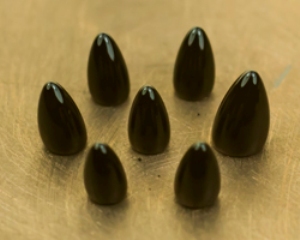Jul 23 2013
This is the first time researchers have demonstrated reversible switching between static and dynamic self-assembly.
 Static self-assembly of seven magnetic droplets on a copper substrate with superhydrophobic coating. Photo: Mika Latikka ja Jaakko Timonen
Static self-assembly of seven magnetic droplets on a copper substrate with superhydrophobic coating. Photo: Mika Latikka ja Jaakko Timonen
Researchers from Aalto University and Paris Tech have placed water droplets containing magnetic nanoparticles on strong water repellent surfaces and have made them align in various static and dynamic structures using periodically oscillating magnetic fields. This is the first time researchers have demonstrated reversible switching between static and dynamic self-assembly.
"We are conducting this line of research because it opens up a way to create new responsive and intelligent systems and materials," said Dr. Robin Ras of Aalto University.
Self-assembly is a process in which multiple components form organized structures or patterns without external direction. The process is very interesting both for scientists and industry, because many natural systems rely on self-assembled structures and they can further inspire technological applications.
"The structure formation can either be static, driven by energy minimization, or dynamic, driven by continuous energy feed. Over the years we have managed to create functional materials based on static self-assembled hierarchies. This model system paves the way towards even more versatile dynamic materials, wherein the structures are formed by feeding energy," said Academy Professor Olli Ikkala.
By using the new model system, the researchers demonstrated that static droplet patterns can transform reversibly into dynamic ones when energy is fed to the system via an oscillating magnetic field. The transition was observed to be complex and the most complicated patterns emerged when the energy feed was just enough to enter the dynamic self-assembly regime.
In addition to the hard science behind the self-assembly, the droplet patterns are also visually captivating.
"In some patterns, the motion of the droplets resembles that of dancing. We find it simply beautiful," said Dr. Jaakko Timonen.
This work is part of the newly completed doctoral thesis of Jaakko Timonen at the Aalto University Department of Applied Physics. It is a multidisciplinary research, combining expertize in magnetic nanoparticle synthesis, superhydrophobic surfaces, and in-depth understanding of self-assemblies.
"Jaakko Timonen´s broad expertize was instrumental in combining three seemingly unrelated fields: magnetic nanoparticles water repellent coatings, and self-assembly," said Dr. Ras.
The results were published in Science on July 19, entitled “Switchable Static and Dynamic Self-Assembly of Magnetic Droplets on Superhydrophobic Surfaces”. (sciencemag.org)